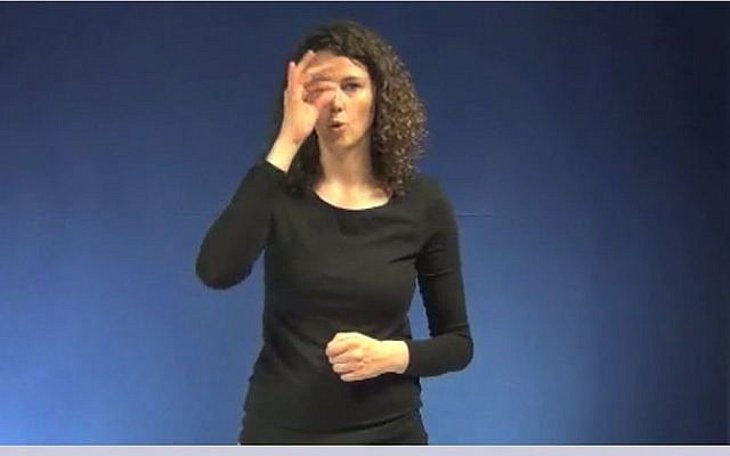 Iran’s Attack on Israel
Iran’s Attack on Israel


4 min read
3 min read
11 min read
5 min read
The recent controversy over an online sign language dictionary shines a spotlight on anti-Semitic signs.
European Jews are calling on the University of Ghent, Belgium, to remove an offensive video from its online dictionary of Flemish Sign Language vocabulary.
The online dictionary includes signs for thousands of words. “Jew” is depicted by five different signs, each with its own video. Two show a person signing Jew by stroking an imaginary beard, which is a widely used sign for Jew in many nations’ sign languages. (The thinking behind this sign is that a common image many people have for a Jew is a man with a beard.)
 A woman gesturing a hooked nose on the website if the University of Ghent, Belgium.
A woman gesturing a hooked nose on the website if the University of Ghent, Belgium.
One video shows a woman indicating the outline of a large nose. Another video of the same woman exaggerates the outline even more, indicating a huge nose over her own. Both, the online dictionary explains, mean “Jew”. (The dictionary does indicate that these signs carry a negative connotation.)
These grotesque signs using exaggerated hook-noses are “simply racist and demeaning to Jews” notes European Jewish Association Director Menachem Margolin, who has urged the university to remove the offensive videos.
Flemish Sign Language isn’t the only national sign language to contain offensive signs denigrating Jews. Like other languages, sign languages vary from country to country, and evolve over the years. Contemporary sign languages were generally developed within the past 400 years and contain vast regional differences. One major development has been the elimination of racist and demeaning signs, replacing them with more neutral or positive signs.
“Miming a hook nose to refer to Jewish people is...now deemed unacceptable by signers, who have replaced the old sign with one involving a hand resting against a chin and making a short movement down, in the shape of a beard,” one British newspaper noted several years ago, referring to British Sign Language.
One way to sign Jew is using a sign that also means “misery”.
Mark Zaurov is an expert in sign languages, culture and life of deaf and hard of hearing people, a doctoral student at the University of Hamburg, and a former research fellow at Yad Vashem and the United States Holocaust Museum. In an Aish.com interview, he explained that the origin of several sign languages’ words for Jew and Jewish-related terms have anti-Semitic origins.
For instance, in French and Spanish sign languages one way to sign Jew is using a sign that also means “miserly”. Mr. Zaurov describes it as moving two fingers under the chin, moving from left to right while the signer brings their fingers together. “Deaf people can see immediately the metaphor for miserly. It’s also used in Morocco and Algeria.”
Mr. Zaurov notes that in Ukrainian sign language one way to sign Jew is to depict a horn coming out of one’s head.
Signing a horn coming out of a head used to exist in American Sign Language as well, where the sign was used to refer to Moses. (This echoes Christian translations of the passage in Exodus 35:29 that depicts Moses radiantly coming down from Mount Sinai holding the two tablets. Whereas the Hebrew says he had “keren or”, rays of light emanating from his face; in some Christian versions of the Bible this was changed to the word for horn in Latin, leading some people to say that Moses - or even all Jews - had horns.) It has since been replaced by a sign emphasizing Moses’ role as a law-giver.
Russian and Estonian sign languages sign Jew by making a squiggly line down the side of one’s face, like a sidelock. In Ukrainian sign language, this movement seems even more exaggerated, featuring a dramatically long and curly imaginary sidelock. While not overtly anti-Semitic, these signs seem to stress the otherness of Jews and emphasize peyot in an extreme way.
The use of a beard in depicting Jews also gave rise to using a similar sign for “stingy”, tapping into a long-standing anti-Jewish stereotype. In American Sign Language, “stingy” was once signed by making a beard-like sign for Jew, then grasping with a fist. While many sign language users have made efforts to become more sensitive and politically correct in recent years, some signs for cheap or stingy still feature a beard-like tugging movement at the chin.
In Swedish sign language, the sign for stingy can be even more overtly Jewish, showing a hand miming a curly sidelock down the side of one’s face.
Some countries describe Jews in more creative or positive-seeming ways. In Turkish sign language, Jew can be signed by cupping a hand over the head like a kippah. In many sign languages, the sign for Israel is similar to that for Jew, but in Brazilian Portuguese sign language, Israel is signed by making a triangle with fingers against one’s chest, first upside down then right side up, then down again, like making the Jewish star on Israel’s flag.
It’s time for the faculty at the University of Ghent to retire the offensive hook nose signs to depict Jews. Doing so will be another step in the continuing evolution of sign languages to be more sensitive to Jews and other groups.
